[Editor’s Note: Recent operations against the Islamic State of Iraq and the Levant (ISIL) to liberate Mosul illustrate the challenges of warfighting in urban environments. In The Army Vision, GEN Mark A. Milley, Chief of Staff of the Army, and Dr. Mark T. Esper, Secretary of the Army, state that the U.S. Army must “Focus training on high-intensity conflict, with emphasis on operating in dense urban terrain…” Returning Mad Scientist Laboratory guest blogger Dr. Nir Buras leverages his expertise as an urban planner to propose a holistic approach to military operations in Megacities — Enjoy!]
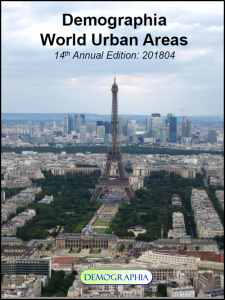 A recent study identified 34 megacities, defined as having populations of over 10 million inhabitants.1 The scale, complexity, and dense populations of megacities, and their need for security, energy, water conservation, resource distribution, waste management, disaster management, construction, and transportation make them a challenging security environment.2
A recent study identified 34 megacities, defined as having populations of over 10 million inhabitants.1 The scale, complexity, and dense populations of megacities, and their need for security, energy, water conservation, resource distribution, waste management, disaster management, construction, and transportation make them a challenging security environment.2
With urban warfare experience from Stalingrad to Gaza, it is clear that a doctrinal shift must take place.
Urban terrain, the “great equalizer,” diminishes an attacker’s advantages in firepower and mobility.”3 Recent experiences in Baghdad, Mosul, and Aleppo, as well as historically in Aachen, Seoul,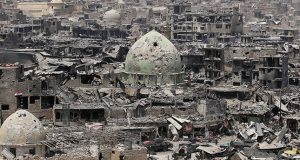 Hue, and Ramadi, shift the perspective from problem solving to critical holistic thinking skills and decision-making required in ambiguous environments.4 For an Army, rule number one is to stay out of cities. If that is not possible, the second rule of warfare is to manipulate the environment.
Hue, and Ramadi, shift the perspective from problem solving to critical holistic thinking skills and decision-making required in ambiguous environments.4 For an Army, rule number one is to stay out of cities. If that is not possible, the second rule of warfare is to manipulate the environment.
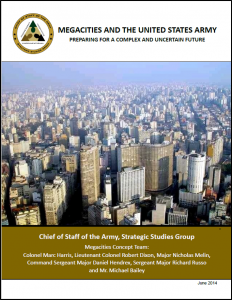 The Strategic Studies Group finds that a megacity is the most challenging environment for a land force to operate in.5 But currently, the U.S. Army is incapable of operating within the megacity.6 The intellectual center of gravity is open to those who choose to seize it, because it does not exist.7
The Strategic Studies Group finds that a megacity is the most challenging environment for a land force to operate in.5 But currently, the U.S. Army is incapable of operating within the megacity.6 The intellectual center of gravity is open to those who choose to seize it, because it does not exist.7
Cities are holistic entities, but holism is not about brown food and Birkenstocks. Holism is a discipline managing whole systems which are more than a sum of their parts. Where problem-solving methodology drags the problem with it, resulting in negative synergies (new problems); the holistic methodology works from aspiration and results in positive synergies, many of which are unforeseen. The aspiration for megacity operations is control, not conquest. The cure must not be worse than the disease.
The holistic approach to combat, to fight the urban context, not the enemy, means reconfiguring the environment for operational purposes. Its goal of reforming antagonism to U.S. interests by controlling and reforming the city to  become self-ruling and long-term sustainable, would facilitate urban, political, and economical homeostasis in alignment with U.S. interests and bequeath a homeostatic urban balance legacy — “Pax Americana.”8 Paradoxically, it may be the most cost-effective approach.
become self-ruling and long-term sustainable, would facilitate urban, political, and economical homeostasis in alignment with U.S. interests and bequeath a homeostatic urban balance legacy — “Pax Americana.”8 Paradoxically, it may be the most cost-effective approach.
Megacities are inherently unsustainable and need to be fixed, war or not. Classic planning for megacities would break them down into environmentally controllable chunks of human scaled, walkable areas of 30,000, 120,000, and 500,000 persons by means of swathes of countryside. A continuous network of rural, agricultural, and natural areas, it would be at least 1-mile deep, and be the place where transport, major infrastructure, highways, campuses, large-scale sports venues, waste dumps, and even mines, might be located.
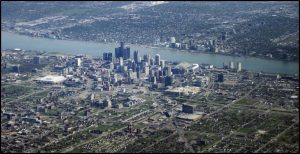 This is naturally ongoing in Detroit, is historically documented to have happened in Rome, and can be witnessed in Angkor Wat. While the greatest beneficiaries of this long-term would be the populace, its military benefits are obvious. The Army would simply accelerate the process.
This is naturally ongoing in Detroit, is historically documented to have happened in Rome, and can be witnessed in Angkor Wat. While the greatest beneficiaries of this long-term would be the populace, its military benefits are obvious. The Army would simply accelerate the process.
The idea is to radically change the fighting environment while bolstering the population and its institutions to sympathize with U.S. goals. “Divide and conquer” followed by a sustainable legacy. Notably, operations within a megacity requires an understanding of a city’s normal procedures and daily operations beforehand.9 The proposed framework for this is the long-term classic planning of cities.
The application of classic planning to megacity operations follows four steps: Disrupt, Control, Stabilize, and Transfer.
1. DISRUPT urban fabric with swathes of country at least a mile wide containing a continuous network of rural, agricultural, natural, and water areas at least 1-mile deep, where transport, major infrastructure, highways, campuses, large-scale sports venues, etc., are located. In urban fabric, structures would be removed to virgin ground, and agriculture and nature reinstated there. Solutions for the debris will need to be developed, as well as for buried infrastructure. The block layout may remain in whole or part for agricultural and forest access. Soil bacteria may be used to rapidly consume toxic and hazardous materials. This has to be thoroughly planned in advance of a conflict.
2. CONTAIN urban fabric to a 1 hour walk (2 hours max), 2-4 miles from edge to edge, both in existing fabric and in new settlements for relocated persons.
3. STABILIZE neighborhoods, quarters, and city centers hierarchically, and densify them, up to 6-8 floors tall, according to the classic planning model of standard fabric buildings. Buildings taller than 6 or 8 stories may be placed on the periphery, if they are necessary at all. Blocks, streets, plazas, and parks are laid out in appropriate dimensions. Proven, traditional designs are used for buildings at least 85% of the time. Stabilize communities through leadership, mentoring, the establishment of markets, industry, sources of income, and community institutions.
4. TRANSFER displaced communities to new urban fabric built on classic planning principles as developed after the Haiti Earthquake; and transfer air rights from land reclaimed for country to urban fabric centers (midrise densification) and peripheries (taller buildings as necessary). Transfer community management back to residents as soon as possible (1 year). Transfer loyalty; build community; develop education, mentoring, and training; and use civilian commercial work according to specifically developed management models for construction, economic, and urban management.10
To adopt a holistic approach to the megacity, the U.S. Army must engage in a comprehensive understanding of the environment prior to the arrival of forces, and plan the shaping of the environment, focusing on its physical attributes for both the benefit of the city and the Army. This holistic approach may generate outcomes similar to the type of synergies stimulated by the Marshall Plan after World War II.
If you enjoyed this post, please listen to:
– Tomorrow’s Urban Battlefield podcast with Dr. Russell Glenn, hosted by our colleagues at the Modern War Institute.
… and also read the following:
– Mad Scientist Megacities and Dense Urban Areas Initiative in 2025 and Beyond Conference Final Report
– Where none have gone before: Operational and Strategic Perspectives on Multi-Domain Operations in Mega Cities Conference Proceedings
– My City is Smarter than Yours!
Nir Buras is a PhD architect and planner with over 30 years of in-depth experience in strategic planning, architecture, and transportation design, as well as teaching and lecturing. His planning, design and construction experience includes East Side Access at Grand Central Terminal, New York; International Terminal D, Dallas-Fort-Worth; the Washington DC Dulles Metro line; work on the US Capitol and the Senate and House Office Buildings in Washington. Projects he has worked on have been published in the New York Times, the Washington Post, local newspapers, and trade magazines. Buras, whose original degree was Architect and Town planner, learned his first lesson in urbanism while planning military bases in the Negev Desert in Israel. Engaged in numerous projects since then, Buras has watched first-hand how urban planning impacted architecture. After the last decade of applying in practice the classical method that Buras learned in post-doctoral studies, his book, *The Art of Classic Planning* (Harvard University Press, 2019), presents the urban design and planning method of Classic Planning as a path forward for homeostatic, durable urbanism.
1 Demographia World Urban Areas 11th Annual Edition 2015,” Demographia, 2-20, September 18, 2015, accessed December 16, 2015, http://www.demographia.com/db-worldua.pdf. 67% of large urban areas (500,000 and higher) located in Asia and Africa.
2 Jack A. Goldstone, “The New Population Bomb: The Four Megatrends That Will Change the World,” Foreign Affairs, (January/February 2010) 38-39; National Intelligence Council, Global trends 2030 Report: Alternative Worlds (Washington, DC: National Intelligence Council, 2012), 1. Quoted in Kaune.
3 ARCIC, Unified Quest Executive Report 2014 (Fort Eustis, VA: US Army Capabilities Integration Center, 2014), 1. Quoted in Kaune.
4 Harris et al., Megacities and the US Army, 22. Louis A. Dimarco, Concrete Hell Urban Warfare from Stalingrad to Iraq (Oxford, UK: Osprey Publishing, 2012) 214-215. Quoted in Kaune.
5 Harris et al., Megacities and the US Army, 21.
6 Kaune.
7 David Betz, “Peering into the Past and Future of Urban Warfare in Israel,” War on the Rocks, December 17, 2015, accessed December 17, 2015, http://warontherocks.com/2015/12/peering-into-the-past-and-future-of-urban-warfare-in-israel/. Quoted in Kaune.
8 Tom R. Przybelski, “Hybrid War: The Gap in the Range of Military Operations” (Newport, RI: Naval War College, Joint Military Operations Department), iii.
9 Kaune.
10 Michael Evans, “The Case Against Megacities,” Parameters 45, no. 1, (Spring 2015): 36. Quoted in Kaune.

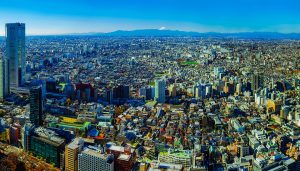


Be careful what you wish for.
The Megacity challenge boils down to the existence of an ungoverned and ungovernable citadel on the lines of communication and supply of a military operation. It needs to be neutralized as a threat and to stay neutralized. In an era where the cost and complexity of the profession at arms negate future Stalingrads, the urban charnel house capable of swallowing entire Divisions is no longer a feasible operating environment.
In this context, the re-birth of the “City Buster” nuclear weapon cannot be discounted. Nothing says “Problem solved, and problem solved PERMANENTLY” like 10 Megatons of blinding doctrinal clarity and unmistakable nation-state intent. Faced with the prospect of interminable, grinding block to block and house to house warfare bleeding offensive operations dry of troops and resources, the temptation for future commanders to “cut to the chase” through resort to a weapon of inviting convenience and conclusive finality cannot be underestimated. Neither can the situational justification for deployment of such a weapon, as distasteful as it may seem to contemporary military ethics.
Received the following response from Dr. Nir Buras to Mr. Jonathan Fox’s comment (above):
“Problem solving creates more problems.
A responsible military today might need to consider the nature of the outcomes, not just the “problem solved.” As a former soldier, I always felt it wasn’t just what we are doing in the field, but what comes after as well. How many times have battles been won, just to lose the war?”
Received the following comment from Mr. Collin A. Agee:
“I’ve got some misgivings about this article. Just a few, to get the
discussion started:
1. “The intellectual center of gravity is open to those who choose to seize it, because it does not exist.7”
Does this even make sense? Is this a logical or useful application of the term, “center of gravity” or just the inappropriate use of a buzzword? The footnote is to a previous article in War on the Rocks.
2. “The holistic approach to combat, to fight the urban context, not the enemy, means reconfiguring the environment for operational purposes.”
Fight the urban context, rather than the enemy? What does THAT mean? Do you agree? (I think the enemy would agree.)
3. “Its goal of reforming antagonism to U.S. interests by controlling and reforming the city to become self-ruling and long-term sustainable, would facilitate urban, political, and economical homeostasis in alignment with U.S. interests and bequeath a homeostatic urban balance legacy – “Pax
Americana.”8 Paradoxically, it may be the most
cost-effective approach.”
So, if the premise is that megacities are best avoided, because they overwhelm our capacity, then the solution is to fix every aspect of them? This strikes me as monumental overreach, the establishment of an unattainable goal.
4. “While the greatest beneficiaries of this long-term would be the populace, its military benefits are obvious. The Army would simply accelerate the process.”
Simply. OMG.
5. “[S]tructures would be removed to virgin ground, and agriculture and nature reinstated there.”
Okay, so we’re not just going to secure, seize, pacify or occupy. We’re going to completely remake them into something
pastoral . . .
Thoughts?”
Received the following response from Dr. Nir Buras to Mr. Collin Agee’s comment above:
“1. “The intellectual center of gravity is open to those who choose to seize it, because it does not exist.7”
Yes, “center of gravity” is a buzzword and it fits here.
2. “to fight the urban context, not the enemy, means reconfiguring the environment for operational purposes.”
Fight the urban context, rather than the enemy?
Same as “fighting topography rather than the enemy.”
What does THAT mean?
In the urban context it means reshaping the parts of the city to our ends.
3. “Pax Americana.” the most cost-effective approach.”
Waging peace is cheaper than waging war.
So, if the premise is that megacities are best avoided,
No.
“they overwhelm our capacity,”
I wouldn’t have written this review they didn’t.
the solution is to fix every aspect of them?… “monumental overreach?”
Just what we need to be fixed. What’s the option? Every soldier knows not to engage in urban warfare. Period. But if we do, the amount of force necessary to actually win is monumental. Otherwise it becomes a cyclical war of attrition (Gaza) and leaves behind total ruin (Mosul). Everyone loses.
4. “While the greatest beneficiaries of this long-term would be the populace, its military benefits are obvious. The Army would simply accelerate the process.”
Simply. OMG.
????
5. “Okay, so we’re not just going to secure, seize, pacify or occupy.”
No. We’re going to clear, isolate, manage, and turn over, part by part, on our terms, on our schedule.
“We’re going to completely remake them into something pastoral . . .”
Urban and Pastoral, Town and Country. Think of what comes after war… peace. Control the peace and you have won the war.
Dr. Buras,
Thanks for your responses.
There is much worthy of comment, but I’ll offer just one for now:
You wrote, “Waging peace is cheaper than waging war.”
This sounds great, both efficient and humane. But I think our experience, historical and contemporary, reveals that it’s not that simple.
Our involvement in Afghanistan appears to be at an inflection point, prompted by those who question the 18 years we have already been there, and the murky prospects for resolution or an enduring end state any time soon. Peacemaking, peacekeeping, nation-building: We have found them all to be expensive, inconclusive and interminable.
Apply that to a megacity, and the challenge becomes larger–and unattainable. It’s an admirable goal, but I fear it is wishful thinking. And I’m having a hard time conceptualizing the force structure and doctrine that would enable us to accomplish what you propose.